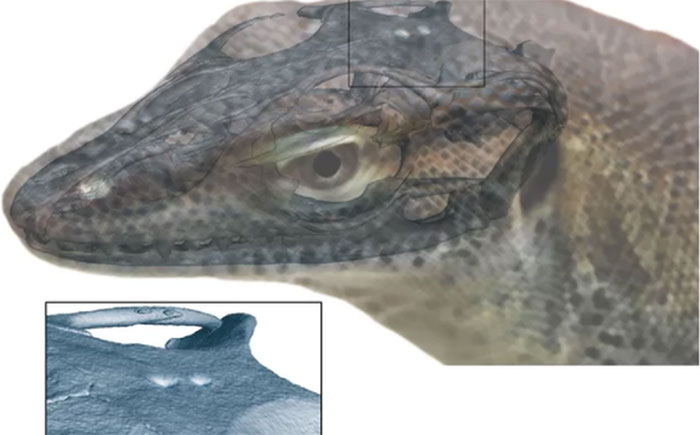Why do lizards have 4 eyes?
A new study shows that, about 49 million years ago, the first long-tailed lizard appeared in the world, but not with two eyes but four eyes.
According to the researchers, all species of lizards, called Saniwaensidens , were the first jawbone animals in the world to record a four-eye record. To this day, the rock-laced species of jawbone are the only four-eyed creatures known among vertebrates.
The third and fourth eyes of S. ensidens are on the top of its head , this is the location of the pineal gland and the lateral gland parts of the lizard. Optical structures like the eye also play a role in orientation and in the annual circulatory cycles.

The team's researchers say the discovery is helping researchers understand the evolutionary history of the pineal and pineal gland organs in vertebrates.
The researchers note that this light-sensitive pinecone organ is found in a handful of lower vertebrates, such as fish and frogs that lay eggs in the water. This light-sensitive organ spreads to lower-order vertebrates that scientists call a 'third eye'.
Lead researcher Krister Smith, a sociologist at the Senckenberg Research Institute in Germany, said in a statement: 'On the one hand, there is an opinion that the third eye is simply eliminated in a toxic way. Set up in various groups of vertebrates, such as mammals and birds, and kept only in lizards, vertebrates that live completely on the ground. On the other hand, there is an opinion that this lizard's third eye develops from another organ, called the pineal gland, that is well developed in the hawks' areas.
The new eyes seen in S. ensidens help clarify this controversy.
Smith said: 'By discovering a four-eyed lizard, in which both the pineal and pineal organs form the eye on the top of the head, we can confirm that the third eye of the real lizard different from the third eye of other vertebrates.
Smith and colleagues discovered by looking at two specimens of the S. ensidens museum collected nearly 150 years ago at Grizzly Buttes in the Bridger Basin, Wyoming, and researchers discovered a lizard It measures 4.3 feet (1.3 meters) long into the CT scanner (CT), takes thousands of X-rays and then stitches them into 3D digital images.
CT scans show that the old lizard, which went extinct about 34 million years ago, had formed the space in its skull where the fourth eye had developed, a discovery that Smith had to utter. that 'I never dared to expect this'.
This discovery shows that the pineal gland is not the same as the eye in modern vertebrates. The findings, the researchers said, suggest that the third eye of the lizard evolved independently of the third eye in other vertebrate groups.
Although other organs may also be photosensitive, these third eyes help some lower-class vertebrates better sense light and guide their path on the ground.
- Video: Horned lizard spits blood from his eyes, attacking the opponent
- Superhuman lizards: Like worms that grow their hands, spend their whole lives in the ground without fear of hunger
- Detecting lizards 'penguin limbs amputated'
- Why people do not need to have three eyes?
- Discover new lizards in Kon Tum
- Detecting lizard-legged lizards
- The world was once dominated by a toothless giant
- 19 most obsessive eyes in the history of world photography
- Strange reproductive practices of lizards
- Observe the extremely rare 'reverse evolution' lizard species in the natural world for the first time
- The species of Florida lizards evolved rapidly due to invasive species pressure
- Discovered new lizards living isolated for millions of years
- Discover more new flying lizards
- Decode the phenomenon of tail-growing lizards
 Discovered an ancient centipede fossil 99 million years old
Discovered an ancient centipede fossil 99 million years old Discovered bat-like dinosaurs in China
Discovered bat-like dinosaurs in China Discovered a 200-year-old bronze cannon of the coast
Discovered a 200-year-old bronze cannon of the coast Discover 305 million-year-old spider fossils
Discover 305 million-year-old spider fossils What is the fastest muscle in the body? I bet 99% of people get it wrong!
What is the fastest muscle in the body? I bet 99% of people get it wrong!  Super Typhoon Milton's 'pinhole eye' appears, why is it extremely dangerous?
Super Typhoon Milton's 'pinhole eye' appears, why is it extremely dangerous?  American startup provides scientific eye implants for blind people
American startup provides scientific eye implants for blind people  Found a 1,500-year-old talisman against 'evil eye'
Found a 1,500-year-old talisman against 'evil eye'  The Fascinating Science of Ophthalmology
The Fascinating Science of Ophthalmology  What is special about fish eyes to make them see clearly underwater?
What is special about fish eyes to make them see clearly underwater? 